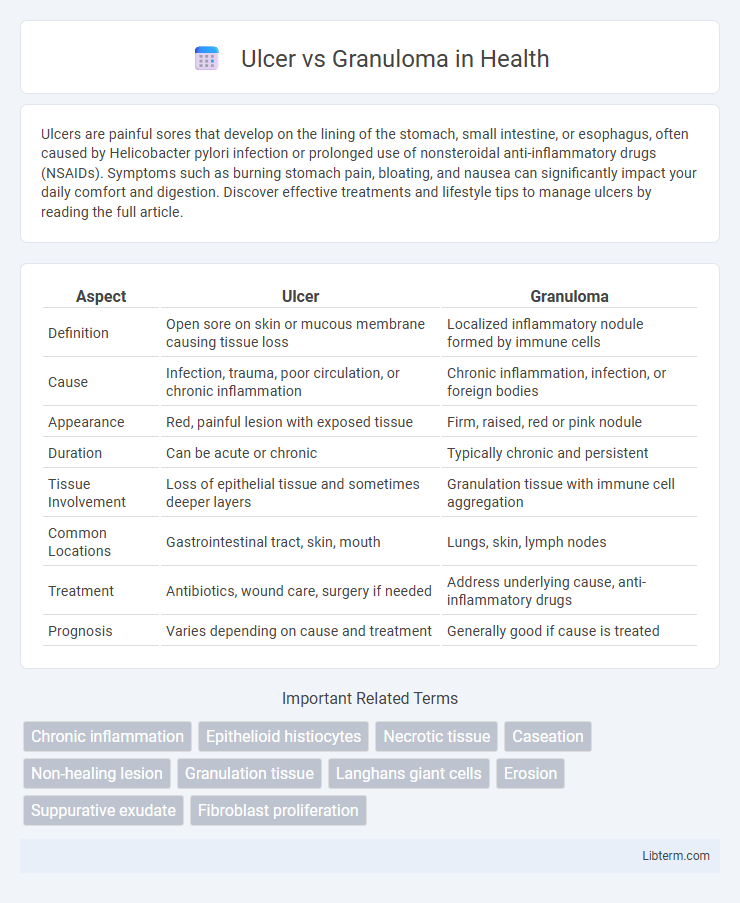Ulcers are painful sores that develop on the lining of the stomach, small intestine, or esophagus, often caused by Helicobacter pylori infection or prolonged use of nonsteroidal anti-inflammatory drugs (NSAIDs). Symptoms such as burning stomach pain, bloating, and nausea can significantly impact your daily comfort and digestion. Discover effective treatments and lifestyle tips to manage ulcers by reading the full article.
Table of Comparison
| Aspect | Ulcer | Granuloma |
|---|---|---|
| Definition | Open sore on skin or mucous membrane causing tissue loss | Localized inflammatory nodule formed by immune cells |
| Cause | Infection, trauma, poor circulation, or chronic inflammation | Chronic inflammation, infection, or foreign bodies |
| Appearance | Red, painful lesion with exposed tissue | Firm, raised, red or pink nodule |
| Duration | Can be acute or chronic | Typically chronic and persistent |
| Tissue Involvement | Loss of epithelial tissue and sometimes deeper layers | Granulation tissue with immune cell aggregation |
| Common Locations | Gastrointestinal tract, skin, mouth | Lungs, skin, lymph nodes |
| Treatment | Antibiotics, wound care, surgery if needed | Address underlying cause, anti-inflammatory drugs |
| Prognosis | Varies depending on cause and treatment | Generally good if cause is treated |
Understanding Ulcers and Granulomas
Ulcers are open sores on the skin or mucous membranes caused by tissue breakdown, often due to infection, inflammation, or pressure, leading to prolonged healing. Granulomas are localized nodular inflammations composed of macrophages, formed as a protective response to chronic infection or foreign substances. Differentiating ulcers from granulomas involves understanding that ulcers represent tissue loss, while granulomas indicate a contained immune response to persistent irritants.
Defining Ulcers: Causes and Characteristics
Ulcers are open sores that develop on the skin or mucous membranes due to tissue breakdown, often caused by factors like infection, prolonged pressure, or inflammatory conditions. They are characterized by a loss of surface tissue, necrosis, and often inflammation, with common types including peptic ulcers, pressure ulcers, and diabetic foot ulcers. Unlike granulomas, ulcers involve tissue erosion rather than a localized collection of immune cells responding to persistent inflammation or infection.
What Are Granulomas? Key Features Explained
Granulomas are small, organized clusters of immune cells that form as a response to chronic inflammation or infection, often seen in diseases like tuberculosis and sarcoidosis. These structures consist mainly of macrophages, epithelioid cells, and multinucleated giant cells, surrounded by lymphocytes. Unlike ulcers, which are open sores on the skin or mucous membranes, granulomas represent a localized immune attempt to isolate harmful agents and prevent their spread.
Pathophysiology: How Ulcers and Granulomas Develop
Ulcers develop through the breakdown of the epithelial lining due to prolonged inflammation, ischemia, or infection, leading to tissue necrosis and loss of the mucosal surface. Granulomas form as a result of a chronic inflammatory response, where macrophages aggregate and differentiate into epithelioid cells to isolate persistent pathogens or foreign substances that cannot be eliminated. The key difference lies in ulcers causing tissue erosion, while granulomas represent organized collections of immune cells aiming to contain irritants.
Clinical Presentation: Signs and Symptoms
Ulcers present as open sores with a necrotic base, often accompanied by pain, redness, and swelling, typically found on mucosal surfaces or skin. Granulomas appear as firm, raised nodules or lumps caused by chronic inflammation, usually painless but may cause localized tenderness or discomfort. Both conditions can exhibit redness and swelling, but ulcers show tissue breakdown while granulomas represent a localized immune response encapsulating foreign material or infection.
Diagnostic Approaches: Distinguishing Ulcers from Granulomas
Diagnostic approaches to distinguish ulcers from granulomas rely heavily on clinical examination, histopathological analysis, and imaging techniques. Ulcers typically present as mucosal breaks with necrotic bases visible upon inspection, whereas granulomas are characterized by nodular, firm lesions often confirmed through biopsy showing granulomatous inflammation with multinucleated giant cells. Advanced imaging like MRI or ultrasound may assist in identifying the depth and tissue involvement, aiding in differentiating ulcerative lesions from granulomatous masses.
Risk Factors Associated with Ulcers and Granulomas
Ulcers are often linked to risk factors such as prolonged pressure, poor circulation, diabetes, and immune system deficiencies, which impair skin integrity and healing. Granulomas typically arise due to chronic inflammation from infections like tuberculosis, autoimmune diseases, or foreign body reactions, indicating an immune response to persistent irritants. Understanding these distinct risk factors is crucial for effective diagnosis and tailored treatment strategies.
Treatment Options: Ulcer vs Granuloma Management
Ulcer treatment typically involves infection control with antibiotics, wound cleaning, and use of topical agents to promote tissue regeneration, while severe cases may require surgical debridement. Granuloma management often centers on addressing the underlying cause, such as infection or inflammation, with corticosteroids, immunosuppressive drugs, or surgical excision if persistent. Both conditions benefit from tailored therapies focused on eliminating causative factors and supporting tissue repair to prevent recurrence.
Complications and Prognosis
Ulcers can lead to complications such as infection, delayed healing, and in severe cases, perforation or bleeding, significantly impacting prognosis depending on the ulcer's underlying cause and location. Granulomas, typically resulting from chronic inflammation or infection like tuberculosis, may cause tissue damage but generally have a better prognosis when the underlying cause is treated effectively. Both conditions require accurate diagnosis and management to prevent progression, with ulcers often posing a higher risk of acute complications compared to granulomas.
Prevention Strategies and Patient Education
Ulcer prevention strategies focus on minimizing factors such as prolonged pressure, poor hygiene, and underlying health conditions like diabetes that compromise skin integrity. Granuloma prevention involves early treatment of infections and avoiding chronic inflammation by managing foreign bodies or irritants effectively. Educating patients about proper wound care, signs of infection, and the importance of regular medical check-ups enhances early detection and reduces complications associated with both ulcers and granulomas.
Ulcer Infographic

 libterm.com
libterm.com